1. Airships
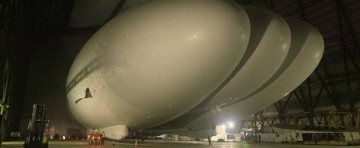
Airlander reached a milestone in its Return to Flight programme by floating for the first time in October 2015. Image source: Hybrid Air Vehicles
There are those who mourn the loss of the airship which, nearly 80 years after the Hindenburg disaster, has been reduced to a novelty advertising bollard. Yet zeppelins and dirigibles are starting to make a comeback as the skies over Siberia darken with the return of the once futuristic design that is back in vogue. It has been revived by the mining industry which cannot afford to build roads and bridges to support 4x4s, never mind the 87-tonne trucks needed to extract nickel, copper and gold from mines. No wonder heavy metal star Bruce Dickinson of Iron Maiden is investing in a 302-foot airship called the Airlander that is the largest in the world.
2. Airlines
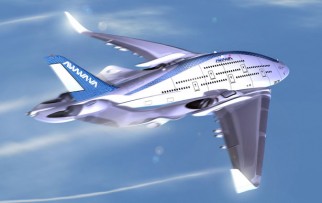
The three-storey AWWA Sky Whale design by Oscar Viñals. Image source: Oscar Viñals
The airline industry may have lacked a real wow factor this year despite the long-haul plans of Qantas to carry passengers from London to Perth without a stopover. However, the three-storey AWWA Sky Whale, the brainchild of Barcelona’s Oscar Viñals, seems a more likely vision of what airline passengers can expect when boarding a plane in 20 years’ time. The potential behemoth, with an 88-metre wing span, can seat 755 people who will benefit from seats akin to those in cinemas and virtual reality controls, while the plane can take off from a standing start. It has yet to get off the ground, but some form of the Sky Whale looks likely to be where increasingly huge planes are heading.
3. Bikes

The Laserlight from Blaze projects a symbol of a bike onto the road ahead to make cyclists more visible. Image source: Blaze
The humble bicycle has been the source of near-constant innovation ever since it was invented. Yet the future of cycling will be as much about the environment around the cyclist as the machine itself. Blaze, a small British company backed by Sir Richard Branson, has put bike-shaped holograms on the road a few metres ahead of the real bike so drivers can see them before they get there. Meanwhile Swiss company Stromer has plugged its electric bike into the web to unlock new routes and traffic information for the rider. Much of the focus of smart cities has been about connected cars, but places such as Ljubljana in Slovenia have instead designed their regeneration around two wheels, not four.
4. Cars
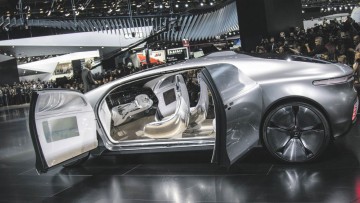
Mercedes F 015 Luxury in Motion concept car at the North American International Auto Show
Car shows have been taken over by technology companies so it was only a matter of time before gadget shows were hijacked by auto makers. For all the talk about Google’s autonomous cars and Apple’s plans, it was Mercedes that stole the show at this year’s CES (Consumer Electronics Show) in Las Vegas with the F 015 concept car which can drive itself using 3D cameras, ultrasonic sensors and radar. Touch-screen windows monitor passengers’ eye movements to adjust temperature and music volume for comfort, and the cabin is designed more like that of spaceship than a traditional car. Concept is the key word with Mercedes trying to move the debate about autonomous cars from one of safety and utility to consideration of comfort and style.
5. Monorail
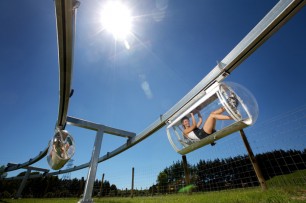
Shweeb monorail pod prototype in Rotorua, New Zealand. Image source: Shweeb
Did the people at Google not see that episode of The Simpsons where the residents of Springfield were fleeced by a monorail project? Obviously not as the technology giant has invested $1 million in turning a wacky human-powered overhead monorail project from Rotorua, New Zealand, as part of a bet on the future of transport. The Shweeb was developed as an extreme racing sport where contestants would enter a pod hanging from an overhead cable and pedal furiously as a team. Google has seen an opportunity to turn that Kiwi frivolity into a real-world green transport solution. Perhaps there’s a use for all those old telephone poles and wires once all the copper is retired after all.
6. Rail
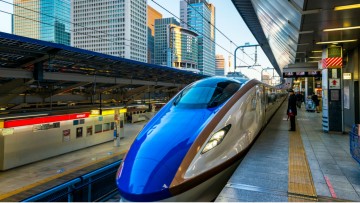
The Japanese Shinkansen, or bullet train, pulling into Tokyo station
It was the 1964 Olympics that led the Japanese government to invest in its famous bullet train network and the impending 2020 Tokyo games have triggered plans to set a new standard for rail. The upgrade of the link to Haneda Airport is expected to cut the travel time to central Tokyo from half an hour to 18 minutes, with the first part of the project to be delivered in time for the Olympics. It is a long way off the dream of “vacuum trains” – airless tubes that could propel passengers along at speeds of 2,500mph and cut the commute between New York and London to just over an hour – but the Japanese plan is more pragmatic. For now, the prospect of vacuum trains remains in the realm of science fiction.
7. Water
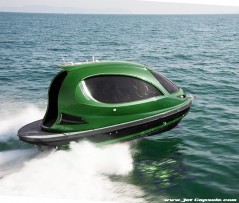
The Jet Reptile can reach a speed of 50 knots. Image source: Jet Capsule
It looks like something dreamt up for a 1970s Bond film, but the Jet Reptile could prove a practical way to zip around the waterways in the future. Pitched somewhere between a mini-luxury yacht and a fibre glass buoy, the Reptile can seat nine people comfortably and is aimed at wealthy young yacht owners who want to jet their friends between parties and restaurants along the coast. A powerful engine means the Naples-made vessel can reach a speed of 50 knots. The company behind it, founded by an Italian car designer, has also developed a prototype water taxi on the lightweight design, looking forward to the mainstream.
1. Airships

2. Airlines

